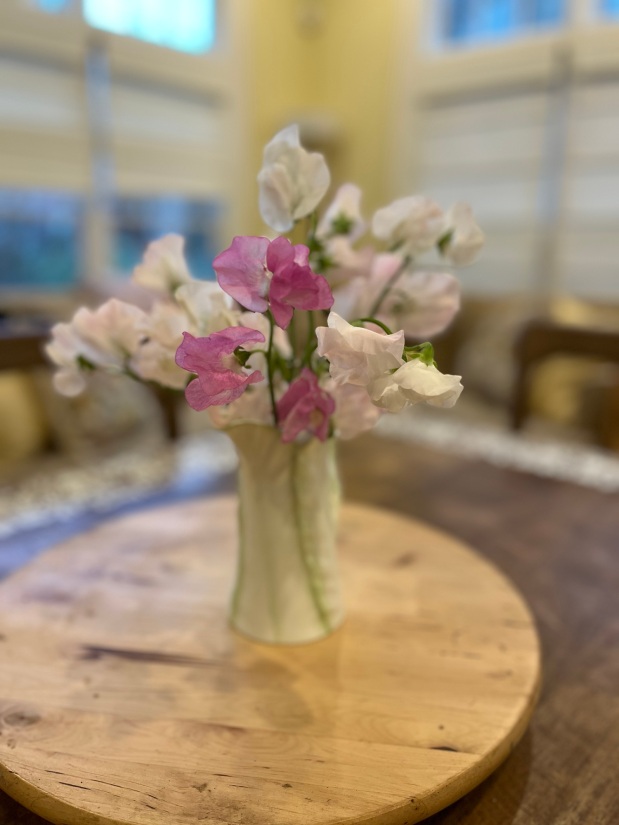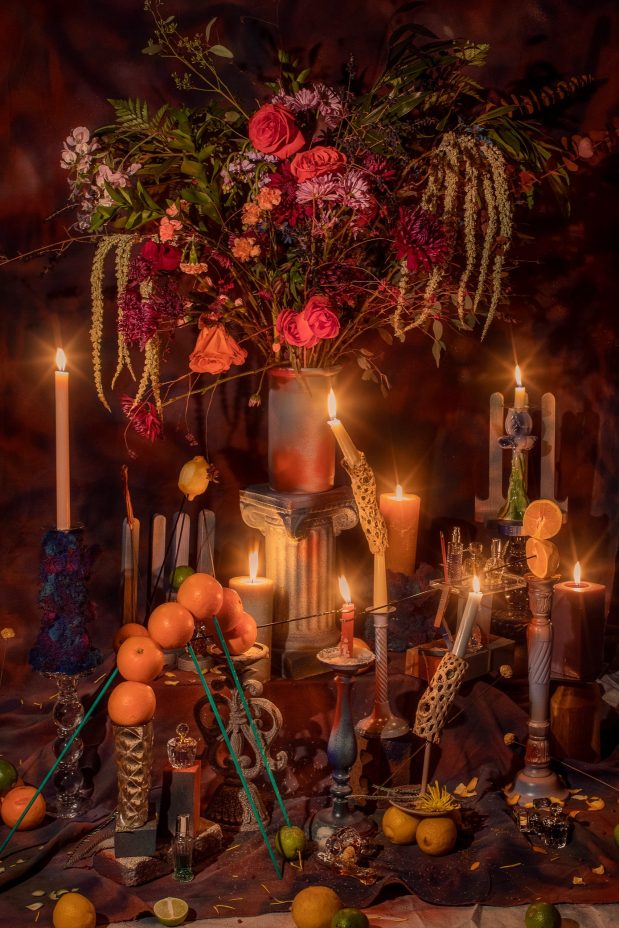The second of the three “White Collection” fragrances by Atelier des Ors is Crepuscule des Ames, which means “twilight of the souls.” It represents the second, or center, panel of Gustav Klimt’s “Beethoven Frieze, a masterpiece of the Vienna Secession movement. That panel actually consists of two halves: the more famous one, featured above, and this one:

Gustav Klimt, Beethoven Frieze, “Gnawing Grief.”
One description of these center panels notes that they represent the forces that stand in opposition to human happiness:
The giant Typhoeus (the monster with mother-of-pearl eyes extending across the entire front wall with his blue wings and snake-like appendages); his daughters, the three gorgons (the three women standing to the left of Typhoeus). Sickness, madness, death (the mask-like female heads above the gorgon heads). Lasciviousness, wantonness, intemperance (the group of three women to the right of Typhoeus. Intemperance wears a conspicuously ornamented blue skirt with applications of mother-of-pearl, bronze rings, etc.). Gnawing grief (the woman cowering on the right in the picture). The yearnings and desires of humankind fly past them. (Suites Culturelles)

Left side of middle section, Gustav Klimt’s Beethoven Frieze.
Perfumer Marie Salamagne and creative director Jean-Philippe Clermont have chosen to represent these hostile forces in a more benevolent light for purposes of fragrance — a wise choice! Here is Atelier des Ors’ own description of Crepuscule des Ames:
Crépuscule Des Âmes is the twilight of the souls and a perfume to enslave the senses with fine spices and a warm golden glow. A second skin to wear in the dusky hours while the souls are at play, when we feel deep desires and the duality inherent in our consciousness. A radiating warmth that speaks to carnal pleasure and desire imbued with the furry warmth of Typhoeus. Incense, patchouli and hyraceum heat the primitive, animalic aura. For moments when we seek the truth, to find a way through temptation. An addictive, empowering fragrance with an element of intrigue.
The opening of Crepuscule is a strong, sweet note of mandarin orange, warmed by the spice of cardamom and the herbal tones of clary sage. The orange note is one of three citrus notes that unite the three fragrances (Nuda Veritas, Crepuscule des Ames, and Choeur des Anges). They are all based on the orange tree (neroli, mandarin, and blood orange with orange blossom) and they connect the three fragrances like a golden thread running through a complex tapestry of scent. In his excellent review for Fragrantica, Sergey Borisov pointed out that in the frieze, this center panel represents the “human sins and passions we have to overcome in order to reach happiness in life,” which is why this scent is designed to evoke the animal side of human nature, portrayed so vividly in the frieze.
As Crepuscule dries down, it becomes more animalic and smokier, with the addition of incense, hyrax, pimento pepper, and patchouli. As described by the brand, these notes are intended to symbolize warmth, carnality, desire, the dark side of the human spirit, the temptations through which we must progress in order to find happiness. The hyrax note is especially interesting. In its natural form, it comes from hyraceum, which is basically crystallized urine of the animal called hyrax. It is used in perfumery as an animalic substance whose collection does not harm any animals, but which “gives an animalistic, sensual and deep note that feels like a combination of musk, civet, castoreum, tobacco and agarwood.” Hyraceum also contains pheromones, complex airborne scent molecules, generated by animals, that are thought to cause behavioral responses in others of their species, including sexual response.
My nose can definitely sense the animalic undertones of Crepuscule, though I wouldn’t have known it came from hyraceum without guidance from a list of notes. I believe it is this complex note that makes Crepuscule feel to me more like a masculine-leaning fragrance than Nuda Veritas, although they and Choeur des Anges are all presented as unisex fragrances. Its use here is very clever (all of Ms. Salamagne’s creations for Atelier des Ors are designed with high intelligence and layers of meaning), especially combined with incense and hyssop.
Why those two notes in particular? Incense is most famously used in Western cultures as part of Christian religious worship, especially in the more ancient rites of the Roman Catholic church. To many lovers of fragrance, incense will immediately evoke memories of church rituals and ancient places of worship: the very passages through which, in the Christian faith, sinners must pass in order to withstand temptation and progress to the ultimate spiritual joy and salvation. I chose deliberately to write about Crepuscule today, which is Good Friday, the day on which Christians believe that Jesus allowed himself to be sacrificed by the darker impulses of humanity in order to win all of humankind our salvation, because I think the symbolism of Klimt’s frieze — and thus this scent — lends itself to such an analogy. Even the female figure of “Gnawing Grief” recalls so many artworks that show the agony of Mary, mother of Jesus, at the Crucifixion.
Hyssop also has religious significance. It is an aromatic herb used ritually “in the Catholic ceremonies where the priest puts the hyssop into the ceremonial aspergillum, which he dips into a bowl of holy water” and uses to sprinkle the mixture onto congregants as a blessing. But there is more to hyssop than this benign use — according to Fragrantica, it is also used to make the liqueur Chartreuse (after which the shade of green is named) and to color the famous spirit “absinthe”, widely used and also widely criticized in the 19th century as the notorious “green fairy” that “makes a ferocious beast of man, a martyr of woman, and a degenerate of the infant,” according to one writer. And there, right in the Beethoven Frieze’s center panel, is a “ferocious beast”, Typhoeus. In this perfume, hyssop may stand for the “duality” the brand means to evoke: dark and light, sinful and blessed, together.
In its final phase, Crepuscule lingers on the skin with the incense most dominant to my nose, followed by patchouli. It lasts for several hours even on my dry skin. At this stage, the hyrax is less noticeable as “animalic” but acts more as a fixative base that still lends warmth. After all, even when we succumb to temptation but struggle to resist sin, we are still human!
Like the others in the triptych, Crepuscule des Ames is an intelligent work of perfume art, with many possible meanings, interpretations, and effects unique to the individual who wears it. It does indeed grow on one, although I don’t find it as addictive as the brand’s copy suggests. I have a feeling this is another scent that I would like very much on my husband, although it is clearly suitable for women to wear also. I am enjoying wearing it and thinking about it even as I look forward to the triumph of Easter and the last of the White Collection, Choeur des Anges.
Sample kindly offered by Atelier des Ors; opinions my own.



















